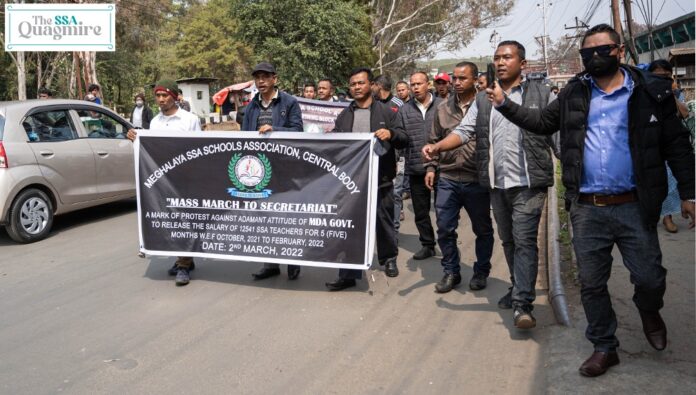Abha Anindita
SHILLONG
The Sarva Shiksha Abhiyan (SSA) was launched in 2001 as the brainchild of the then Prime Minister Atal Bihari Vajpayee. With the aim of catering to goals under the Right to Education, the programme looks at providing elementary education for all children between the age of 6 and 14.
In Meghalaya, after 21 years of implementation, teething problems have not faded away. Recent stirs of the Meghalaya SSA Schools Association (MSSASA) have taken centre stage with scores of teachers from across the state protesting for over a month.
The current health of the programme in the state is bleak, reflecting in the poor educational outcomes of the state as well.
As per the 2020-21 Performance, Infrastructure and Equity Index of notable think tank Observer Research Foundation, Meghalaya has been ranked the lowest in the country in the category of primary and secondary education.
Last year too, as per the Performance Grading Index, Meghalaya featured as one of the worst performing states in the country for school education.
The confusion regarding funding and salaries of teachers is not a novel problem. It goes back many years, right to the beginning of the programme when financial irregularities were observed.
The Comptroller and Auditor General (CAG) report of 2006 highlights that Meghalaya, along with states like Madhya Pradesh and Orissa, had not submitted utilisation certificates (UCs) for Rs 137.24 crore between 2000-05 as of December 2005.
UCs are certificates which show that funds that were allocated were utilised for the intended purpose. Submission of UCs is important as they demonstrate financial transparency and are required for availing funds for the following financial year.
In the case of SSA, non-submission of UCs between 2000-05 meant that the central government had no documentary evidence of utilised funds in the state then, due to which release of funds for particular months had faced a backlog.
Data also suggests that the state, along with Assam and Odisha, had recruited 74,256 excess SSA teachers by 2005. However in 2004-05, funds of about Rs 4.31 crore, meant for the SSA teachers, were diverted to meet the salaries of teachers who were not engaged under the programme.
This meant that many teachers engaged under the SSA were not paid on time, thus creating a backlog in salaries then.
Despite this, the CAG report suggests that the state had additional funds at its disposal which it was supposed to utilise for programme implementation in seven districts between 2002-03 and 2004-05.
But there is neither any record of implementation in any of the seven districts during the period nor is there any information on how the amount was spent.
With all these irregularities in place, the state had failed to comply with the SSA norms to set up check mechanisms for ensuring proper implementation of the programme.
Even up till March, 2005, four years after the implementation of the SSA, Meghalaya had failed to set up an internal audit mechanism, due to which most of the irregularities in the early years of the programme went unchecked and, thereby, unresolved.
Finally, other evaluation reports launched by the state government and other auditing firms suggest that Meghalaya has never utilised SSA funds fully in any year so far.


